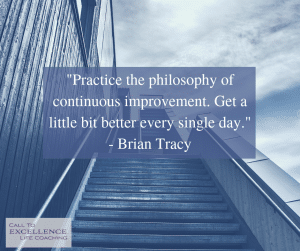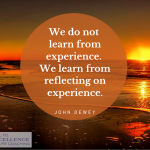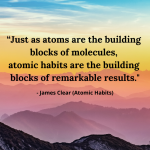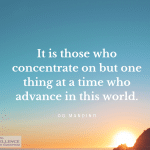
In my 6-month update, I talked about how I was shifting my approach with my “Excellence Experiment” – from working with microresolutions to establish new habits, to using a kaizen-based strategy to integrate small improvements continuously. The way it works now, I sit down on Sunday evening and make a list of 1-2 things I can improve in the coming week in each of the three life areas that I’m focusing on this year. Some are one-time improvements, while some are the beginnings of micro-habits. The main criteria are that they must be achievable within the week, they need to be small and easy enough that they don’t trigger the “fear radar” in the amygdala, and they need to move me toward my vision of personal excellence.
And I’m happy to report – success! At least, so far… but with this strategy, I finally feel like I’m making consistent, steady progress. Plus, this is a system that other people can use too (be watching for a “Do-It-Yourself Excellence Experiment Toolkit” coming in the not-too-distant future!).
Progress
Professional Excellence:
My original microresolution-based focus here was on establishing the daily habits of writing for an hour and reading something in the field of personal development for an hour. Honestly, I still haven’t been able to nail those habits on a regular basis. I find myself skipping some days because my schedule gets crazy, and then going on a writing or reading binge when my schedule lets up. While I still believe these are very worthwhile habits to develop, and they certainly contribute to a foundation for professional excellence as a writer, I realize that I need to make a lot of other changes to get my daily schedule under control before I’ll be able to truly be consistent with these as daily disciplines. Or perhaps, the binge approach will actually work better for me…
Before, I would have felt stuck and frustrated because I’m still struggling with these habits 8 months later… but instead, switching to a kaizen mindset allowed me to identify other ways that I could improve professionally. Some of the improvements I tackled over the past two months included taking a business development class, updating my social media business profiles, starting to revamp my website and upgrading some technical features.
I also experimented with some different strategies to improve my work flow and efficiency, like dividing my week up between my two different businesses. That didn’t help me, but I hit the productivity jackpot when I tried out a few “virtual co-working” sessions. In the process, I discovered how crucial having other people around – either virtual or in person – is to my productivity and sanity. As an “ambivert” (midway between extrovert and introvert on the Meyers-Briggs scale), I need some alone time to recharge, but too much solo work is demotivating and de-energizing. Being around other people who are working diligently keeps me focused. So, my next challenge is to find even more ways to create a co-working environment throughout the week.
Image and Self-Care (Exercise, Healthy Eating, and Overall Image)
This was another area where I felt like I was stalled when I focused on microresolutions, like drinking water (very erratic) or going shopping weekly to revamp my wardrobe (even more erratic). Again, worthy habits, but I realized that focusing on the habit itself was demotivating, at least for me. I don’t enjoy shopping, so why on earth would I want to make a habit of dragging myself to the mall every week? But when I shifted the goal to a tangible improvement, like “find gray shoes to go with X and Y outfits” or “get blue and silver earrings to match favorite blue sweater”, all of a sudden I had a mission that inspired me to shop! Now, with at least one piece a week, I’m finally making progress towards creating a wardrobe that I love.
As for the exercise and healthy eating goals, I’ve made some tangible improvements here, too. I’ve started stretching and going for a short walk in the evenings, on top of my regular exercise regimen. Now, those sound like micro-habits – and they are – but my focus is on loosening up tight muscles, getting in more steps, and feeling less lethargic after dinner – the payoff, rather than the habit itself. I’ve also increased my run/walk intervals, upped the weights I use for squat, shoulder, and chest exercises, and found some healthier snacks I can bring along when I travel to avoid overindulging in airports. And the good news is that all of these little changes have finally tipped the scale in the right direction.
“Living Excellently”
This was the one area where the microresolution approach was working fairly well. Since the beginning of the year, I’ve developed a habit of pushing myself outside of my comfort zone, I started meditating daily, and I began volunteering at a local animal shelter. All of these things have helped to improve my quality of life, and I plan to continue them.
In fact, I’ve even branched out to stretch a different part of my comfort zone – the one walled in by fear of rejection. In August, I took a big leap and invited a few high-profile guests for interviews as part of my Profiles in Excellence series. Unfortunately, but perhaps not surprisingly, I didn’t get the positive response I was hoping for – so I encountered rejection head-on. But, I discovered it wasn’t all that bad – the disappointment stung a little, but it wasn’t devastating. And more importantly, I discovered that the boundary of my comfort zone had stretched in the process – the other day I realized I no longer hesitate over initiating connections with people when there’s a much smaller risk of rejection (situations where in the past, I would have had considerable angst about reaching out, and often missed opportunities because I hesitated too long). Happily, most of these people have been very happy to connect!
To add a little kaizen to this life category, I’ve decided to work on my environment. In the book “Declutter Your Mind”, authors S.J. Scott and Barrie Davenport note that “Where you choose to spend time every day ultimately determines the quality of your life.” This is so true – although I’ve devoted a lot of time and energy to de-cluttering my home, and I’ve replaced a few things, it doesn’t have that comfortable, pulled-together feeling. Walking in the door triggers a low-level feeling of irritation, like a pebble in my shoe, rather than a sense that I’m entering a peaceful sanctuary..
So, I’m applying kaizen to home improvement – so far, I’ve resurrected my habit of eliminating one piece of clutter a day, cleaned out a desk drawer, replaced some frayed bathroom rugs (and the feeling of happiness when I step on my new super-plush mats is outlandish!), and tried a few options to replace my uncomfortable desk chair (the stability ball was fun for a few days, but the novelty wore off quickly). I’ve also started devoting 15 – 30 minutes a day to “life stuff”, and I’m almost caught up my to-do list – for the first time ever!
Lessons Learned
As you can see, the improvements I’ve made so far have been small, things I could easily get done in a week, but they have contributed disproportionately to my overall satisfaction and sense of accomplishment. Individually, they don’t seem like much, but kind of like making a snowball, they start to accumulate.
One of the biggest lessons I learned from this shift is how important feeling like I’m making progress and being able to “see” changes is for me to stay motivated and enthusiastic. Many of the specific goals that I’m working towards, and even the general goal of “living excellently”, are goals that are going to take a significant amount of time to accomplish. I have a tendency to focus on the gap between where I am and where I want to be, and this can get frustrating. The kaizen approach of making small improvements in the right direction gives me something to celebrate every single week, and this has really helped to minimize the amount of time I spend in “frustration mode”. I also keep a running list of the improvements I’ve made each week, a visible reminder of the gap between where I was and where I am now, which is much more affirming.
Another thing I learned about using a kaizen approach is that it creates positive momentum and energy. There’s no rule that says you can’t go above and beyond the small target goal for the week, so in some cases when I’ve achieved one of the items early in the week, I’ve started looking around to see what else I can do, because that one small accomplishment felt so good that I want more!
I’m also finding that kaizen is more flexible and forgiving than a microresolution approach. Sometimes I’ll start the week planning to work on one improvement, but then my mood changes or an opportunity comes up, and I’ll switch to something else mid-week. For example, my wardrobe goal this week was to find some strappy blue heels, but I wound up getting some new earrings that I also needed instead. I improved something and moved forward, so I was successful.
When I was focused on microresolutions, I felt like I needed to stick to the plan perfectly, or I had failed for the week. Even though I could see positive results from my imperfect attempts (like an accumulation of words written, blogs posted, and books read), I still felt like I was failing because I didn’t write or read every single day. Even worse, I didn’t feel like I could move on to something else until I got a specific microhabit “right” consistently.
In contrast, if I slip with a specific kaizen goal, I try to find some other way I can improve in that area for the week, and I roll the original goal over to the next week, or scale it back, or turn it into a multi-week goal. Or, if an improvement turns out to not really improve anything (like my stability ball experiment), I’ve learned something that I can then use to come up with a better idea. In the cases where I’m actually developing a micro-habit, like stretching in the evening, if I don’t do it every day, I just count the number of days I did do it, and then try to top that number the next week. There are just more ways to feel successful and to stay positive using kaizen, at least in my experience.
If it sounds like I’m sold on kaizen, you’re right. But please don’t think I’m dissing the microresolution approach. I think both strategies for change work, but they have different strengths. Based on my experience, I think microresolutions may work better when you’re generally content with your life, and just want to make small, gradual tweaks – like being a little neater or more organized, or tightening up your eating habits.
But in my opinion, if large-scale transformation is what you’re after, kaizen seems to work better. Aside from the points I’ve already mentioned, there’s something mysterious and almost magical about the kaizen process – at some point, the tiny changes create a new pathway in the brain, the momentum builds, the process starts picking up speed, and you start making bigger changes without any conscious effort. Like the way 30 seconds of moving during a commercial break turned me from a coach potato into a runner, and eventually led to 3 half-marathons – THAT was never even a flicker of a goal when I started.
While I wish I had started out the year using more of a kaizen approach, I think the real-life comparison of the two strategies has been valuable. Plus, there’s still 4 months left for my year-long “experiment”, and I’m excited to see what I can still accomplish in that time. And I’m already envisioning an “Excellence Experiment 2.0” to test out how far kaizen can take a person if given a full year 🙂 I hope some of you will join me!







12 thoughts on “The Excellence Experiment: 8-Month Update”
Hi Susan, excellent read once again.
1) Documenting your progress for us to follow through is a great opportunity for us to learn from you and see what aspects we can incorporate into our own different patterns. Thank you for doing this.
2) You seem to be achieving quite a lot using these approach; so just keep it up and keep improving one day at a time.
3) I’m in complete support of breaking tasks into bit-sized parts…really helps you achieve
a lot. I personally had the same experience where I kept facing overwhelm for more than 5 years…but eventually started making progress when I adopted this approach you mentioned.
(Take a look at my story here. https://www.ultimatelyfulfilledlife.com/achieve-more-do-less/).
4) I totally agree with you on co-working, it has the capacity to literally multiply your
productivity by a factor of 3. After the first session with George Kao, I finally got around to trying
http://www.focusmate.com; and since then I got hooked. I can’t speak too highly of it. Luckily it’s free!
Thanks once again for sharing this.
Thanks Captain! I do hope that my experiences give people ideas about ways they can make the changes they want in their own lives. Kaizen is the most powerful method I’ve ever found for getting unstuck, and also for conquering overwhelm. It doesn’t seem like it should work, the steps seem so small, but it is amazing how quickly they add up. And thanks for the tip on Focusmate – I just signed up and will be trying out my first session today!
I like how you have show some examples of “Living Excellently”. It somehow inspired me to push myself outside of my comfort zone too and try something more challenging and take it as a fun approach. I usually stay away from something that is hard or unfamiliarwith. I like traveling and usually prefer travel in more advance country with clean environment but recently I have tried some countries that is very backward and with poor facilites. I guess that is part of stepping outside of my comfort zone. Thanks for sharing your journey to adopt Kaizen approach, Susan as it keep motivating me.
Aw, I’m so glad to hear that you’ve been inspired to stretch your comfort zone 🙂 I think your travels around the world are definitely an example of “Living Excellently” – I always enjoy reading your posts about these exotic locales and I admire your courage! Keep stepping outside your comfort zone and inspiring the rest of us to be more adventurous 🙂
Makes me feel that living excellently is a tall order… But staying on the positive side that if we care each of it one time at a time we’ll definitely ace it. (y)
I think “Living Excellently” means different things to different people, and the important thing is to develop your own personal definition and then pursue it. It doesn’t have to be intimidating, especially if you take a Kaizen approach and focus on small, even tiny, steps to continually improve in some way that is important for you. It’s all about living your life to the fullest and exploring your full potential, and that’s different for every one of us 🙂
I always look forward to your posts because I feel like they have lessons within that stay with me far long after reading. I appreciate your candor in not trying to appear perfect and your documentation of what works and doesn’t. I’ve been doing a little de-clutter around my home and doing it in more manageable chunks then one overwhelming panic inducing clean. it’s against the kon Marie method but I don’t think that works for most people unless you can hire an aide to do it for you!
Thank you Janna! As a recovering perfectionist, I’ve discovered it is so freeing to just be transparent about the ups and downs of my journey – the funny thing is, when I look at the people I admire most, they are also people who are open about their shortcomings but who are on a continual upward path – it’s the way they handle their struggles that teaches and inspires me 🙂
Your posts inspire me to keep going especially at the times when I want to give up . Progress to me as the post proves can be attained by small sustained efforts . When I try to do too much or go too hard I often end up frustrated and feeling like a hamster on a wheel . This approach to me makes the most sense to my over all self improvement .
Aw, I am so glad to hear that Tachi – I love to encourage people 🙂 You are not alone – the “success gurus” have us all brainwashed into believing that if we want to achieve our goals we have to “go big or go home”, but that approach doesn’t work for most people, and in reality, it’s not the approach that got most high achievers to the top – most of them started small, and spent years and years learning, practicing, and consistently making small improvements before they had their big breaks. You can make big progress with small sustainable steps 🙂
Love this! All too often, I (like many people) go for an all-for-nothing approach when it comes to accomplishing my goals, trying to do much at once, and end up demoralized and depleted. I was grateful to find to-do lists that are organized in such a way that I could actually get all the items accomplished in one day as opposed to feeling guilty at the end of the day! I also like how you go into detail about your personal experience with both of these approaches.
Thank you Kate! I agree – the all-or-nothing approach doesn’t work for most people – that’s why 93% of New Year’s resolutions fail. Thankfully, there are other ways, like kaizen, that can produce equally powerful end results. And so true about the to-do lists – I used to find mine overwhelming, but now I keep a master list, and pick just three or four tasks to focus on for my daily list, and that has really cut down on the frustration factor, because now the daily list is realistic and achievable 🙂